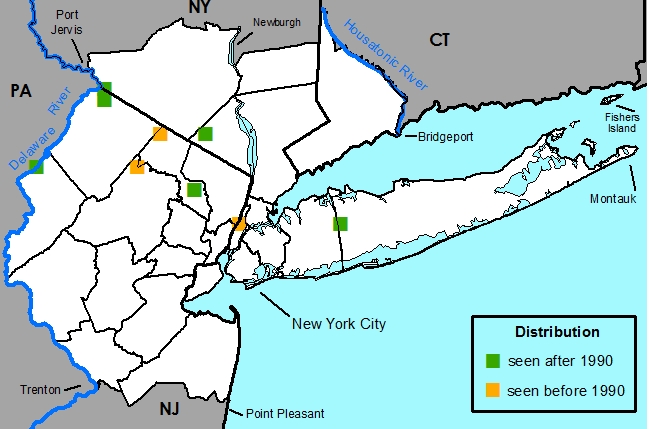Ilex montana Torr. & Gray - Mountain Winterberry,Mountain Holly,Big-Leaf Holly,Hulver

Common Names
Mountain Winterberry,Mountain Holly,Big-Leaf Holly,HulverField Identification
Deciduous large shrub or small tree to 9 m with alternate, simple leaves and with red fruits on female specimens.Food uses
Disclaimer: The information provided here is for reference and historical use. We do not recommend nor do we condone the use of this species for food purposes without first consulting a physician.Medicinal uses
Disclaimer: The information provided here is for reference and historical use. We do not recommend nor do we condone the use of this species for medicinal purposes without first consulting a physician.Poisonous properties
Disclaimer: The information provided here is for reference and historical use. If you believe you have been poisoned, please contact the Poison Control Office near you (look for the number in the front of the phone book).
Ilex fruit and leaves contain an array of potential toxins which can cause moderate to severe nausea, vomiting, diarrhea, and rarely narcosis. Death is unlikely.
Nomenclature
Ilex montana Torr. & A.Gray ex A.Gray, Manual 276. 1848, not I. montana (Sw.) Griseb. 1861.
Ilex ambigua sensu Torr., Fl. New York 2: 2. 1843, not Prinos ambiguus Michx. 1803.
Prinos ambiguus sensu A.W.Wood, Class-book Bot. 2: 243. 1845, not Michx. 1803.
Ilex monticola A.Gray, Manual ed. 2, 264. 1856.
Ilex amelanchier var. monticola A.W.Wood, Amer. Bot. Fl. 208. 1870.
Ilex dubia Trel. ex Loes. in Koehne, Deutsche Dendr. 371. 1893, exclud. basonym.; not Weber 1851, nor Britton et al. 1888.
Ilex dubia var. monticola (A.Gray) Loes., Monogr. Aquifol. 1: 485. 1901.
Ilex dubia var. monticola f. genuina Loes., Monogr. Aquifol. 1: 486. 1901.
TYPE: unknown
Ilex montana var. mollis (A.Gray) Britton in Bull. Torrey Bot. Club 17: 313. 1890.
Ilex mollis A.Gray, Manual ed. 5, 306. 1867.
Ilex dubia Trel. ex Loes. in Koehne, Det. Dendrol. 371. 1893, p.p.; not Weber 1851, nor Britton, et al. 1888.
Ilex monticola mollis Britton in Mem. Torrey Bot. Club 5: 217. 1894.
Ilex dubia var. mollis (A.Gray) Loes., Monogr. Aquifol. 1: 486. 1901.
Ilex dubia var. mollis f. Grayana Loes., Monogr. Aquifol. 1: 487. 1901.
Ilex montana var. Beadlei (Ashe) Fernald in Rhodora, 41: 428. 1939.
Ilex Beadlei Ashe in Bot. Gaz. 24: 377. 1897, nom. subnud.
Ilex dubia var. mollis f. Beadlei (Ashe) Loes., Monogr. Aquifol. 1: 487. 1901.
Ilex dubia var. Beadlei Rehder, Man. Cult. Trees 546. 1927.
TYPE: unknown
Description
HABIT Perennial, deciduous, phanerophytic, shrub, diclinous and dioecious, 1-9 m tall.
STEMS Main stems erect, gray, round. Bark smooth, not exfoliating. Branches erect or ascending. Twigs gray, not odoriferous, terete, 2-4 mm in diam., smooth, glabrous, eglandular, short shoots with imbricate leaf scars on 2nd year+ wood. Pith white, round, continuous, nodal diaphragm absent. Sap translucent.
BUDS Terminal and axillary present, scattered along stem. Bud scale scars not encircling the stem. Leaf scars crescent-shaped; bundle-traces 1.
LEAVES Alternate, simple, spiral, 1-3 per node, spaced somewhat evenly along and divergent from stem. Stipules lateral, deciduous, scale-like, minute, caduceus, dropping shortly after buds open. Leaves petiolate, petiole terete, 0.4-1.5 cm long, glabrous or with long and unbranched erect or spreading hairs, sparse or moderately dense or dense, distributed throughout. Not glabrescent, eglandular. Leaf blades: abaxial surface light green, adaxial surface green, elliptic or ovate or widely elliptic or widely ovate, bilaterally symmetric, 3-9 cm long, 2-5 cm wide, membranaceous, base acute or cuneate, margin toothed, serrate, apex acuminate, abaxial surface with long and unbranched erect or spreading white hairs, sparse or moderately dense or dense, distributed throughout or distributed along midveins, eglandular. Adaxial surface with long and unbranched erect or appressed or spreading white hairs, sparse or moderately dense, distributed throughout or distributed along midveins, eglandular. Venation semicraspedodromous.
INFLORESCENCES Unisexual, fascicle, axillary, also at end of short shoots. Pedicel 3-5 mm long, glabrous, eglandular.
FEMALE FLOWERS Sepals and petals readily distinguishable from one another, 4-merous or 5-merous or more than 5-merous, 4-5 mm wide, fragrance absent, perianth of two whorls. Calyx actinomorphic, persistent. Sepals 4-6, triangular, margins ciliate, apex acute or obtuse, abaxial surface with long and unbranched erect or spreading hairs, sparse or moderately dense, distributed throughout, eglandular. Corolla actinomorphic, deciduous, abaxial and adaxial surfaces white. Petals 4-6, margins ciliate, apex obtuse, abaxial surface glabrous, adaxial surface glabrous, eglandular. Gynoecium syncarpous. Style and stigma 1, stigma capitate. Ovary superior, glabrous. Placentation axile. Androecium abortive, rudimentary and sterile.
MALE FLOWERS Fascicled, axillary. Peduncle 0.3-0.6 cm long. Pedicel 0.3-0.6 mm long, glabrous, eglandular. 4-5 mm wide, perianth of two whorls. Calyx actinomorphic, persistent. Sepals 4-6, triangular, margins ciliate, apex acute or obtuse, glabrous, eglandular. Corolla actinomorphic, deciduous, abaxial and adaxial surfaces white. Petals 4-6, margins ciliate, apex obtuse, glabrous, eglandular. Stamens 4-6. Anthers opening along the long axis, glabrous, eglandular. Filaments free, eglandular. Gynoecium vestigial.
FRUITS Drupe, red, globose, 8-10 mm long, 8-10 mm wide, glabrous, eglandular.
SEEDS Oblong elliptic in outline; trigonal in cross section, 6 mm long, 3 mm wide, glabrous, eglandular, ribbed.
Habitat
Mesic upland woods.Distribution
Native to the eastern United States.
United States -- AL, CT, GA, KY, MA, MD, NC, NJ, NY, PA, RI?, SC, TN, VA, VT?, WV
New York Metropolitan Region -- Native, historically distributed throughout the metropolitan area, now found mostly inland.
Rarity Status
Heritage global rank -- G5
Connecticut -- Not listed
New Jersey -- S1
New York -- Not listed
Species Biology
Flowering
June
Pollination
Probably Mellittophily
Fruiting
July - September
Dispersal
Probably endozoochory by avian frugivores.
Germination
In nature, holly seeds usually germinate from 1-3 years after dispersal, and natural regeneration commonly is sparse. The seeds have hard seed coats and dormant or immature embryos; as a rule they are difficult to germinate. Germination is probably epigeous. Satisfactory germination results have been attained for other holly spp. by first stratifying the seeds in moist sand for 60 days (68 degrees F at night, 86 degrees F by day) followed by 60 days at 41 degrees.